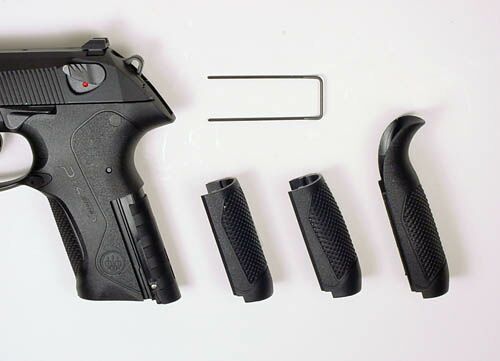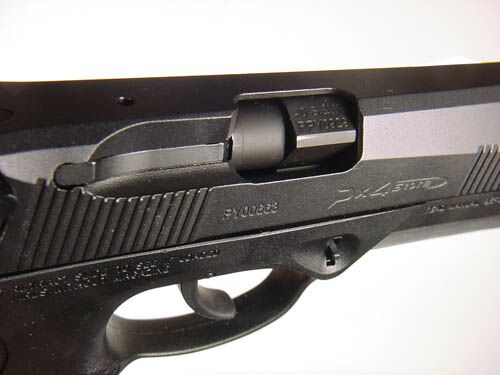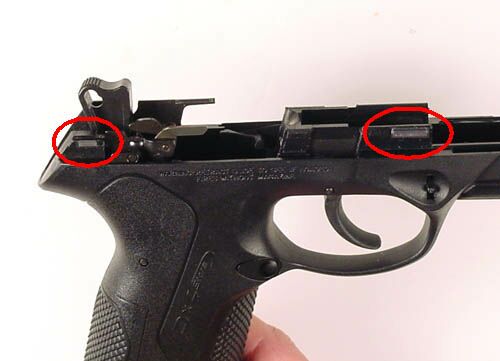By Dan Smith -Genitron.com
A brief history...
Beretta's firearm manufacturing lineage can be traced back as early as 1526 to an Italian long gun barrel maker. Throughout the centuries since, the Beretta family created a notable record of excellence in the manufacture of sporting and hunting rifles. It wasn't until 1915, under the pressure and needs of World War I, that Beretta began making handguns. By the end of the 20th century though, Beretta had become one of the world's major handgun manufacturers. A notable mark of their success was in 1985 when the US armed forces adopted Beretta's 9 mm Model 92 pistol as their NATO compliant side-arm. This deal was conditional on the establishment of manufacturing facilities in the USA, and a factory was built in Accokeek, Maryland operating under the subsidiary company name, Beretta USA.
For twenty years since the early 70's Beretta had kept with basically two handgun designs; the tilt-up fixed barrel, open frame blow-back design of its .22, .25 and .32 caliber small framed Tomcat and Bobcat pistols, and the notable 9 mm and .40 cal. model 92 and 96 short-recoil pistols with their wide open frame and falling block barrel locking system. The .380 cal. Cheetah would take something from both designs. All of them are hammer-fired double-action variants.
Then in 1994 Beretta introduced an all new design called the "Beretta Compact Frame Pistol Family". This pistol had an all-enveloping slide and a unique rotating barrel locking system. It was called the Cougar, and was available in 9 mm, .40 and .45 calibers. This design was quite successful.
Not quite as successful in my opinion was Beretta's first endeavor into a polymer frame pistol, the Model 9000. Introduced in 2000, this design is a compact frame with a dropping-barrel locking system similar to the Kahr and Taurus Millennium, and is available in 9 mm or .40 cal. This compact design suffers from a top-heavy balance and a hard-hitting recoil.
Now, as good as the Beretta Cougar's rotating-barrel design was, particularly for reducing felt recoil, its grip was a little bulky and was a bit too large for some small hands. It was otherwise though, an extremely accurate and reliable gun. After over ten years of production the Cougar was eventually discontinued in 2005.
But, that won't be the last we will see of the Cougar. It has been re-incarnated, enhanced, and has returned as the new polymer framed PX4 Storm.
Specifications -
Caliber: .40 Smith & Wesson
Action: recoil operated semi-automatic
Length: 7.59 in
Width: 1.5 in
Height: 5.51 in
Magazine Capacity: 14 rounds
Barrel Length: 4.0 in
Rifling: 6-grooves, RH twist
Trigger: double-action
Sights: dove-tailed 3-dot
Weight without magazine: 25.8 oz
Weight with empty magazine: 28.9 oz
Weight Loaded (1+14 rd magazine): 37.0 oz
Features -
Reinforced fiberglass technopolymer frame.
Light activated luminescent night sights.
Mil-Std-1913 "Picatinny" accessory rail.
Multiple-sized, reversible magazine release.
Three interchangeable palmswell grip sizes.
Rotating barrel locking system.
Patented Bruniton corrosion-resistant coating.
Internally chromium-plated barrel.
Design Notes -
First is my gripe, and it's about quality control. This is the second new product I've reviewed that has had a quality control problem right out of the box. (Read my review on the M&P.) This one isn't as bad as the first one. It's not a miss-fire issue. But it's aggravating none-the-less, especially when it's an advertised feature of the product. I'm talking about the light activated luminescent night sights, of which, one of the three white dots was virtually gone. Not there. Basically a poor paint job. Extremely poor. And since I had special-ordered the gun, I could foresee the hassle and delay involved with returning it just to get the sight fixed. So, I decided to fix it myself, with the help of BrightSights.com.
On to the good points...
The first unique design point of the PX4 is its rotating barrel locking system. While it's not the first gun ever to use this type of barrel locking action, the PX4 and its predecessor, the Cougar, are just about the only guns deploying the design today, with the exception of the SIG-Mauser M2.
When the slide auto-loads it moves forward scraping a round from the magazine, inserting it into the barrel chamber. When the slide's breechblock mates with the recoiled barrel enclosing the round, it begins to push the barrel forward. As the barrel moves forward with the slide, an angled cam slot in the bottom of the barrel rides a peg in the fixed central block that sets in the frame, causing the barrel to rotate about 45 degrees. This in turn causes lugs in the barrel to rotate into vertical grooves in the slide, locking the barrel tightly to the breechblock.
When the gun is fired, the recoil reverses the process. The cam slot turns the barrel until its lugs are free of the slide. Then a stop on the barrel hits the frame block stopping its rearward motion while the slide continues and extracts the casing. By channeling part of the recoil energy into barrel rotation, and by partially absorbing the barrel and slide recoil shock through the central frame block before it is transferred to the frame, the PX4 achieves unusually low felt recoil. The positive lock-up of barrel to slide assures perfect alignment of barrel and sights. The result is superior accuracy and quicker recovery for the next shot.
Unlike the GLOCK, SA-XD and Smith & Wesson M&P, the PX4 Storm is a traditional hammer-fired pistol. While this is not necessarily unique to polymer frame guns (for instance, check out the Ruger P-345 and the HK USP) the PX4's hammer design is certainly unique. The hammer mechanism of the PX4 Storm has been designed as a single independent module that can be extracted from the frame for deep cleaning and maintenance without the use of special tools.
Of course the new hot feature for polymer frame guns is the interchangeable palmswell. The PX4 provides a small, medium and large size insert to fit your particular hand size.
The PX4 is available in three basic firing schemes. The Model F is double-action (SA/DA) with a slide mounted ambidextrous safety lever that disengages the trigger and acts as a decocker. The Model G is double-action (SA/DA) with a slide mounted ambidextrous decocking-only lever. The Model D has no external safety/decocker, has a spurless hammer that resets to uncocked after every fire, and thus has a trigger that is double-action-only (DAO). All models have an internal firing pin safety.
The particular model reviewed here is the .40 caliber Model F. The PX4 is also available in 9 mm with a 17 round double-stack magazine. I could not find any information as to whether a 357 SIG variant would be available.
The caliber -
The .40 Caliber Smith & Wesson (S&W) cartridge was developed as a joint venture between Winchester and Smith & Wesson in 1989. It was an effort to to create a cartridge with the same power as the 10mm Norma round that the FBI had just started using, but in a shorter case. The shorter cartridge would facilitate accuracy and allow use of a smaller, more comfortable grip frame. The .40 S&W has become the cartridge of choice for many law enforcement agencies in the United States. Typical bullet weight for this cartridge ranges from 135 to 180 grains with an average muzzle energy that approaches 500 ft-lbs.
The following data set is based on standard factory loaded cartridges fired from a 4" barrel, listed by weight, brand, type and muzzle velocity. This is only a very small sample of what is available.
135 grain Federal JHP: 1,190 Feet Per Second
155 grain Hornady JHP: 1,180 Feet Per Second
165 grain Winchester FMJ: 1,060 Feet Per Second
180 grain CCI-Speer JHP: 1,025 Feet Per Second
Handgun Observations -
The PX4 is well balanced in the hand. Although the slide assembly isn't as slim and trim as the Smith & Wesson M&P, it is by no means bulky and in my opinion gives the gun a more sturdy appearance than the M&P. There is absolutely no rattle in the gun when shaken, but there was an ever-so-slight play in the rear of the slide when pressed to the left and right. This is not a complaint. I have seen much more play in the entire slide of other reliable guns. The bottom line is that this gun is tight.
I have seen much more play in the entire slide of other reliable guns. The bottom line is that this gun is tight.
Unlike the glossy finish on it's predecessor, the Cougar, the Bruniton finish on the PX4 slide is more matted, which makes it less susceptible to fingerprints and reflecting light. The slide's matte finish also blends in well with the matte finish on the polymer frame giving the gun a uniform look. The grip serrations on the front and back straps are interesting. Angled crosshatching forms a mass of tiny little pyramids that definitely create traction. The gun will not slip or slide in your hand. But, people with sensitive hands may not be happy with the rasp-like feel.
There is no loaded-chamber indicator. This might have been a nice feature for some, particularly since the rotating barrel locks so securely into the slide that it takes over a 1/4 inch of pull on the slide before the rear of a chambered cartridge is exposed where it can be seen.
Exchanging the palmswell insert is not real easy. It required applying a large flat-blade screwdriver with a hard and steady pressure to remove the retaining clip while being particularly careful not to scratch or mar any of the gun's surfaces. Also, I needed a hard, flat, preferably wooden or other non-marring surface to press the gun against in order to re-insert the retaining clip. I used the edge of my shop bench. This would be much more difficult to do in the field.
Beretta's traditional left side take-down lever has been replaced with a pair of S&W Sigma-like pegs on both sides of the frame that need to be simultaneously pulled down to release the slide. This initially troubled me as those little pegs on my Sigma are so stiff that it's actually painful and aggravating to take-down that gun. Fortunately this is not the case for the PX4. The recessed pegs on either side of the pistol only require a minimal pull to release the slide.
The widest point on the PX4 is at the ambidextrous safety/decocking levers, which at 1.5 inches across, adds an additional .25 inch to the otherwise slender gun. Literature on Beretta's website states that on the Model G variant the levers can be replaced with low profile levers. I'm sure that would require sending the gun back to the manufacturer. This option is not provided for the Model F variant. I assume that this is because the slim profile lever may prohibit a quick single-handed thumb release from the safe position.
Beretta literature indicates that the standard slide-lock lever can be replaced with a low profile version. This would help reduce the profile of the Model D variant which has no safety/decocking levers, or the Model G variant that has had low-profile decocking levers installed. But, it wouldn't necessarily help the profile of the Model F variant that is stuck with standard safety levers.
The slide-lock lever can be easily removed with out any tools. Reversing the magazine release button is a little bit trickier. It requires the use of a properly sized drift-punch to fit into a small maintenance hole in the magazine release button. Beretta literature states that the standard magazine release button can be replaced with a larger "Combat" button. The larger button was not included with the gun.
Shooting -
It's real embarrassing to stand at the bench at your range and be seen struggling with loading rounds into your pistol's magazine. But I could not believe how hard it was to get 14 rounds into the magazines that came with the PX4. It was nearly impossible to get the last round inserted by bare hand. I let my range master try it just to see if it was just me, and he met the same resistance, while uttering disbelief that it was a Beretta magazine. He pulled out a plastic HKS lever-action loader that happened to fit, but it broke under the pressure after about five magazine loads. It appears that the follower binds when pressed downward in the magazine, and it is additionally aggravated by a spring that gets extremely stiff as it is compressed by the last few rounds inserted. I was able to relieve the binding follower with a drop of gun oil, but still that last round is a bear. Otherwise the magazines had absolutely no problems feeding the gun.
Double-action trigger pull measured about 9 pounds with about an inch of travel before it tripped the sear. In single-action mode the trigger had about 1/4 inch of take-up before it tripped the sear at just under 4 pounds. The hammer spur is extremely easy to cock, which made it just as easy to prime the gun for a single-action first shot as it was to just pull the trigger in double-action mode.
The photo-lumeniscent 3-dot sights were easy to see, and made target acquisition quick. They are a low cost and effective alternative to the much more expensive Trijicon style self-illuminating sights. Of course since my factory sights arrived defective and I have since rebuilt them with the Bright Sight "Ghost Glow" product, I won't comment on Beretta's claim that their sights last up to 30 minutes in the dark with just a short exposure to a light source. This will be very subjective and highly dependent on the light source and subsequent ambient lighting conditions.
The gun shot like a charm. It was one of the lightest recoils that I have experienced in a polymer framed .40 caliber gun. The customized grip, the clear 3-dot sights and SA/DA trigger pull made it easy to get consistently tight groupings. As much as I like my Beretta Cougar, I have to say that the PX4 has surpassed it in handling and accuracy.

Beretta's new polymer frame offering. A new and improved descendant of the Beretta Cougar, also available in 9 mm.

Reinforced fiberglass technopolymer frame. Patented Bruniton corrosion-resistant coating on slide. Barrel chrome-plated internally.

Shown here is the Model F, with its ambidextrous slide mounted safety/decocking lever.

The PX4 broken down to its "user" serviceable parts. That's "user" serviceable because the palmswell insert requires a large flat-blade screwdriver to remove it, and is better managed on the bench than in the field. The rest of the components can be broken down in the field without any tools.

Interchangeable palmswell inserts come in small, medium and large sizes.

Here you can see one of the recessed take-down pegs just above the triggr guard. A peg on each side of the gun must be pulled downward, and then the slide assembly easily slides right off.

The unique rotating barrel configuration locks the barrel into the slide in perfect alignment with the sights. The rotating barrel action absorbs energy which reduces felt recoil and muzzle lift.

The serrations on the front and back grip straps definitely provide a non-slip surface. But, the rasp-like pattern may be uncomfortable to some sensitive hands.

The standard PX4 double-stack magazine provides capacity for 14+1 rounds of .40 S&W ammo.

Contiguous steel sub-assemblies imbedded in the molded polymer frame provide hard touch points on which the slide assembly rides.

A flat-blade screwdriver is required to change palmswell inserts.

The factory slide lock and safety levers add an additional 1/4 inch to the overall width of the gun. This profile can be reduced on "G" and "D" models with various low-profile lever upgrades. But, you're stuck with the factory levers on the "F" model.

My only real complaint with the PX4 is with the double-stack magazine. Although designed to hold 14 rounds of .40 cal. ammo, it was painfully difficult to get the last round into the stiff magazine. Two third-party loaders that will fit the PX4 magazine are the HKS Lever-Action Loader and the UpLULA Universal Pistol Loader. The all-plastic HKS loader cracked under the pressure after only five magazine loads, while the UpLULA loader worked flawlessly. Beretta sells a small push-style magazine loader for the PX4 at their online pro shop. A magazine loader is highly recommended.

The PX4 Storm (right) shown with its predecessor, the Cougar (left).

They just don't seem to be putting exploded views of guns in the manuals any more. This is the closest thing you'll find to an exploded view. Call it a "stating the obvious" diagram if you will. What is shown here are the basic configurations of the three models; Model "F" with the safety/decocking lever, Model "G" with the decocking-only lever, and Model "D" with a spurless hammer and no safety lever.